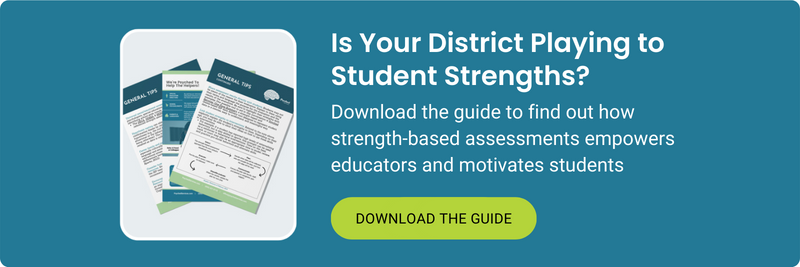
Compared with other states, California has the highest number of English Language Learners (ELLs) at 21 percent of the student population. As the number of bilingual students in our public school system continues to rise, special education teams must adapt in order to provide fair and accurate assessments of ELLs.
According to a study from Samson and Lesaux (2009), bilingual students were underrepresented in special education classes in the primary grades, yet were overrepresented from third grade on. There is also an underrepresentation of ELLs in gifted programs. Without proper assessments, ELLs might appear to need special education or not seem gifted when in reality language acquisition or biased testing adversely impacted the results.
Not every school or district has access to a bilingual school psychologist. However, effective and meaningful assessment of ELLs can be achieved in the absence of bilingual examiners by adhering to these five best practices:
5 Best Practices for Bilingual Assessment
- Ensure proper training. It’s crucial for the school psychologist who will administer the assessment to be knowledgeable about the student’s home culture. This might involve consulting with an agent who is familiar with the student’s home culture. Since the cultural heritage of the school psychologist will play a part in their perspective, it’s important that they be aware of their own preferences and biases by examining the origins of their beliefs, emotions, values, and behaviors. In addition, they must be trained in practices and evaluation materials appropriate for students from diverse backgrounds, which requires ongoing professional development. The National Association of School Psychologists (NASP) is a great resource. NASP has a directory of bilingual school psychologists, some of whom are available to consult with staff remotely.
- Use multiple sources of data. Just like any other assessment, it’s important to draw from multiple sources of data. In the case of ELLs, gathering data from a variety of sources helps reduce the chance of bias or discriminatory assessment. The assessment should begin with a review of the student’s cumulative file, which includes the student’s English Language Development (ELD) level, the language of instruction (i.e. English-only vs bilingual), and the Home Language Survey. In California, the California English Language Development Test (CELDT) measures a student’s proficiency in English. However, as of June 2018 The CELDT was replaced by the English Language Proficiency Assessments for California (ELPAC). The evaluator should review the CELDT and ELPAC results to see if there is a pattern of consistently low performance, as well as consider the scores for each category—reading, writing, speaking, etc. The student’s native language proficiency is also important because their success in acquiring English is directly related to how they are building their native language skills. Additional material in the student’s file, such as behavior reports, attendance records, history of schools attended, report cards, intervention data, and any other assessments completed provide valuable data. The ELL’s health and development records should be reviewed. Interviews should be conducted with the student and with the parents/guardians to gain insight into family dynamics and cultural environment.
- Establish language dominance. Identifying a student’s language dominance will inform which language to use for the rest of the assessment process. There are standard developmental milestones that are consistent regardless of language. Therefore, formal and informal data, including standardized tests, interviews, and other records should be reviewed to see if the student’s English language acquisition is following the expected patterns. The examiner should evaluate basic interpersonal communication skills (BICS) and cognitive academic language (CALP). BICS is the language used when interacting with peers in informal social contexts, such as chatting at recess and at lunch. CALP is more complex language required for academic learning. An English speaking examiner can use an interpreter to assist with test administration in the student’s native language, but it’s important for the interpreter to be trained in how to administer tests properly under the supervision of the examiner.
- Carefully consider tool selection and assessment procedures. When assessing ELLs, always consider test bias. Test bias can slip in through a myriad of ways because all of the instruments and techniques available are influenced by our culture. The tools an examiner uses should be reliable. They should not be racially, culturally, or linguistically discriminatory. Assessment should be administered in the language and form most likely to yield valid results for that particular student. The goal is to accurately assess a student’s skill level and abilities. Depending on the particular circumstances and situation of the ELL, cognitive testing may consist of testing in English, nonverbal measures (when standardized cognitive measures are not available in the student’s native language or when verbal skills are immature), or testing with the use of an interpreter if a bilingual examiner is not available. If a student has received formal instruction in English only, then academic testing should be conducted in English regardless of the student’s native language. However, if the student has received formal instruction in their native language or in both languages, academic testing may need to be conducted in both languages.
- Use data-based decision making. The crux of the challenge for bilingual assessments is to determine if identified deficiencies are related to language differences or if there is a disability that requires intervention. If a disability is identified, the examiner must document ecological validity—that their conclusions are supported by more than one score. Exclusionary factors such as economic disadvantage, lack of school experience, environment, etc. must also be considered as reasons for the student’s learning difficulties.
Since there’s a lot to keep track of when completing an effective assessment of ELLs, it can be challenging to manage.
Is your school ready to make a change? Our seasoned school psychologists and BCBA’s would love to help! It’s crucial to collect the right data and know what to do with it. Click here to schedule a free consultation about what Psyched Services can do for you.





